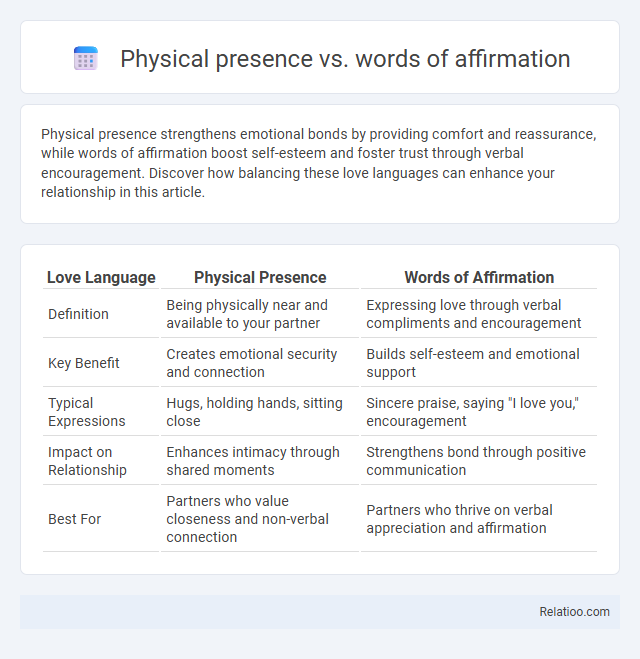Physical presence strengthens emotional bonds by providing comfort and reassurance, while words of affirmation boost self-esteem and foster trust through verbal encouragement. Discover how balancing these love languages can enhance your relationship in this article.
Table of Comparison
| Love Language | Physical Presence | Words of Affirmation |
|---|---|---|
| Definition | Being physically near and available to your partner | Expressing love through verbal compliments and encouragement |
| Key Benefit | Creates emotional security and connection | Builds self-esteem and emotional support |
| Typical Expressions | Hugs, holding hands, sitting close | Sincere praise, saying "I love you," encouragement |
| Impact on Relationship | Enhances intimacy through shared moments | Strengthens bond through positive communication |
| Best For | Partners who value closeness and non-verbal connection | Partners who thrive on verbal appreciation and affirmation |
Understanding Physical Presence in Relationships
Understanding physical presence in relationships involves recognizing its impact on emotional security and connection beyond verbal expressions like words of affirmation. Physical presence provides nonverbal cues such as touch, proximity, and shared activities that reinforce feelings of intimacy and support, often conveying empathy and attentiveness more effectively than words alone. Prioritizing physical presence can strengthen trust and deepen relational bonds by fulfilling innate human needs for closeness and reassurance.
The Power of Words of Affirmation
Words of affirmation hold transformative power by fostering emotional connection and boosting self-esteem more effectively than mere physical presence. Consistent verbal expressions of love and appreciation create a safe space for vulnerability and deepen relational bonds. Research shows that individuals who receive regular affirmations experience increased psychological well-being and relationship satisfaction, highlighting the critical role of meaningful communication.
Emotional Impact: Touch vs. Talk
Physical presence often conveys comfort and security through nonverbal cues like touch, which can significantly reduce stress and enhance emotional bonding. Words of affirmation, by contrast, provide verbal reassurance and validation that nurture self-esteem and emotional connection. The emotional impact of touch vs. talk varies by individual preference, with touch fostering immediate feelings of warmth and safety, while affirming words support cognitive and emotional understanding over time.
Nonverbal Communication: Is Presence Enough?
Physical presence in relationships conveys nonverbal cues such as body language, eye contact, and touch, which often communicate care and attentiveness beyond spoken words. Words of affirmation provide explicit verbal recognition and emotional support, complementing the subtle signals of presence but not replacing the impact of embodied interaction. Effective communication balances physical presence with affirming language to reinforce trust, emotional security, and connection.
The Science Behind Words and Physical Closeness
The science behind words and physical closeness reveals that physical presence triggers the release of oxytocin and dopamine, fostering emotional bonding and reducing stress. Words of affirmation activate brain regions linked to positive emotions and self-worth, enhancing your sense of connection and intimacy. Combining verbal affirmations with physical touch creates a powerful synergy that amplifies emotional security and relationship satisfaction.
Cultural Influences on Love Languages
Cultural influences profoundly shape expressions of love, highlighting the importance of physical presence, words of affirmation, or other love languages based on societal norms and values. In collectivist cultures, physical presence often signifies commitment and support, while individualistic societies may prioritize verbal affirmations to express affection and boost emotional intimacy. Understanding these cultural differences helps you navigate relationships more effectively by aligning your love language with the expectations and communication styles of your partner's background.
Challenges in Long-Distance Relationships
Physical presence in long-distance relationships offers tangible comfort but is often limited by distance, leading to feelings of loneliness and missed non-verbal cues. Words of affirmation become crucial as they provide emotional support and reassurance, yet may sometimes feel insufficient without physical connection. Your challenge lies in balancing frequent, heartfelt communication with the longing for physical closeness to maintain intimacy and trust.
Balancing Physical Presence and Verbal Affirmation
Balancing physical presence and verbal affirmation is crucial for nurturing strong relationships, as your consistent, loving gestures create emotional security while meaningful words of affirmation validate feelings and boost self-esteem. Combining eye contact, gentle touch, and supportive language helps deepen intimacy and fosters trust, demonstrating both attention and care. Prioritizing both physical connection and heartfelt communication enhances emotional bonds and promotes mutual understanding in your relationships.
Identifying Your Partner’s Primary Love Language
Identifying Your Partner's primary love language requires understanding whether they feel most valued through physical presence or words of affirmation. Physical presence emphasizes quality time and face-to-face connection, fostering intimacy and security. Words of affirmation focus on verbal expressions of love and appreciation, strengthening emotional bonds through positive communication.
Tips for Strengthening Connection Through Both Approaches
Maintaining a strong connection requires balancing physical presence with words of affirmation by consistently dedicating quality time together and expressing genuine verbal appreciation. Prioritize active listening and use affectionate language to reinforce emotional intimacy while engaging in shared activities that foster closeness. Combining tactile affection, such as hugs or holding hands, with sincere compliments helps create a deeper, multifaceted bond that nurtures trust and understanding.

Infographic: Physical presence vs Words of affirmation
 relatioo.com
relatioo.com